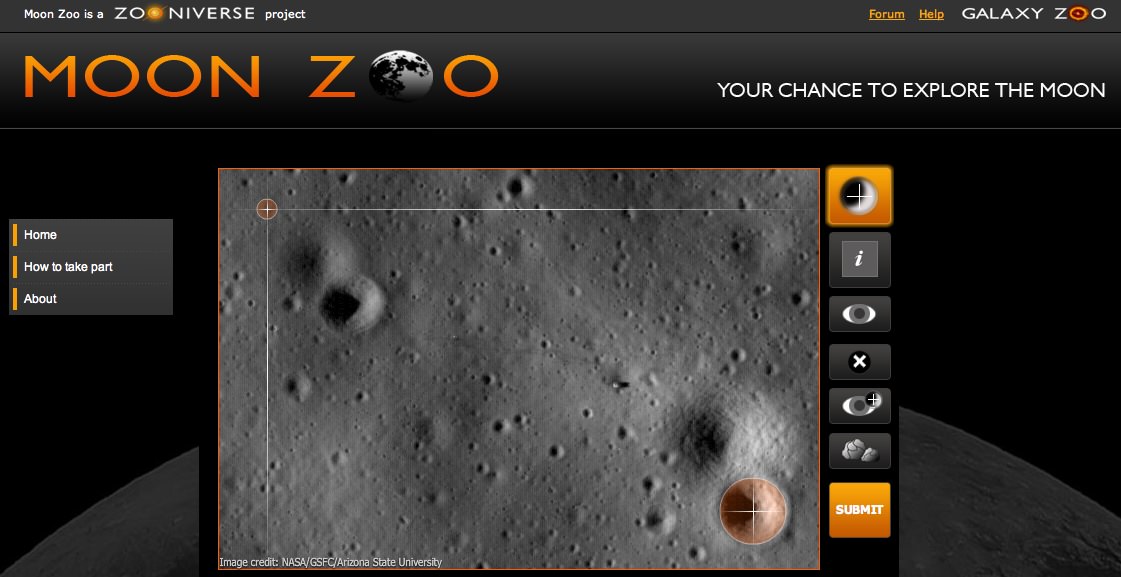[/caption]
Have you ever wanted to explore the Moon? Well, now you can as a virtual astronaut, and you can help lunar scientists answer important questions, as well. New from the Zooniverse — from the same folks that brought you Galaxy Zoo — is Moon Zoo. “We’re asking citizen scientists to help answer different aspects of lunar science and outstanding questions that we still have,” said Dr. Katherine Joy from the Lunar and Planetary Institute and a Moon Zoo science team member.
Moon Zoo uses about 70,000 high resolution images gathered by the NASA’s newest lunar spacecraft. the Lunar Reconnaissance Orbiter. In these images are details as small as 50 centimeters (20 inches) across, and ‘Zooites’ are will be asked to catergorize craters, boulders and more, including lava channels and even all sorts of different spacecraft sitting on the Moon’s surface.
How fun is this latest Zoo project?
“Actually, I have to say after a few days of playing with it I find it much more addictive than the others,” said Chris Lintott, head “zookeeper” of the Zooniverse and chair of the Citizen Science Alliance. “Galaxy Zoo was bad enough but I’m obsessed with the Moon now. I can’t quite believe the variety of the places we’re seeing. People think the Moon is this boring place – they say, ‘we know what it looks like, it’s just grey and flat, right?’ But actually it has its own landscape that is really quite dramatic, especially when the sun is low, so it’s a world well worth exploring.”
Want to join in? Go to the Moon Zoo website, and if you’ve participated any of the previous Galaxy Zoo or Solar Storm Watch projects, you can use the same username and password. If not, it’s easy to sign up.
Under the “How to Take Part” tab you’ll find a tutorial that will teach you how to participate in Moon Zoo.
The two main biggest tasks right now are the Crater Survey, where you can mark all the craters (down to a certain size), and Boulder Wars, where you are shown two images and you determine which has the most boulders.
But Dr. Joy said there will soon be some additional tasks, created from a wish list from lunar scientists. “One of the main tasks we really want to do is to compare these new LRO images to older Apollo panoramic camera images that were taken 40 years ago,” she said. “And what we can do is match these older images against the new images with similar lighting conditions and similar angles at which the camera was pointed at the surface and what we might be able to do is to spot differences that have occurred between 40 years ago and now, which could be in the form of say, new impact craters that have formed from incoming bolides. We might be able to spot new debris flows and landslides that have happened in the past 40 years. This can provide us information about the really recent history of the Moon.”
Questions? There’s a FAQ section and a discussion forum where you can pose queries or discuss any issues or interesting finds with other Zooites.
“We’re hoping to reach out to people that have never really looked at the Moon before in any kind of detail and get them excited about all the secrets the Moon still has,” said Dr. Joy “because there are plenty of new things that people have never looked at before.”
Listen to the May 19, 2010 edition of the 365 Days of Astronomy podcast for an interview with Katie Joy and Chris Lintott.


Hey! This is kind of fun! Fun science? Yassss~
So if we sign up are we unwittingly enlisting ourselves in the war against the aliens on the far side of the moon? Citizen science = lunar intelligence conscripts! Nefarious.
I’ve found that some of the images have peculiarities that are difficult to describe given the number of choices and I end up giving them the selection “Other”. There certainly is an ‘otherworldliness’ in these images! I found one image in particular interesting in that is had an object that looked metallic and very bright – donno what THAT was? Pixel artifact? OR perhaps?
It *is* very addictive, yes.
Thanks for you the updates on what’s planned in future. I’ll be looking forward to comparing Apollo-era stuff to the new images.
I bet that a lot of conspiracy theorists will sign up to finally discover the alien artefacts that NASA is trying to cover up. LOL
Aqua- If you listen to the podcast on 365 Days of Astronomy linked above, Dr. Joy says they are now aware of the issues with the images where there are some pixel artifacts, etc. and are working on the solution. So look for improved images coming soon!
Katie Joy is a very enthusiastic person, it seems that Moon Zoo is destined to become as famous as the other Zoo Projects.
What Chris is doing as Head Zoo Keeper is providing quality programmes for new comers to science (mostly students if you like) to take part in proper projects and get to grips with them.
Keep it up Guys.
Brian – Roseland Observatory.